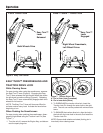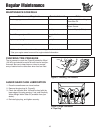
Storage
15
TEMPORARY STORAGE
(30 DAYS OR LESS)
Remember, the fuel tank will still contain some gasoline, so
never store the unit indoors or in any other area where fuel
vapor could travel to any ignition source. Fuel vapor is also
toxic if inhaled, so never store the unit in any structure used
for human or animal habitation.
Here is a checklist of things to do when storing your unit
temporarily or in between uses:
• Keep in an area away from where children may come
into contact with it. If there’s any chance of unauthorized
use, remove the spark plug (s) and put in a safe place.
Be sure the spark plug opening is protected from foreign
objects with a suitable cover.
• If the unit can’t be stored on a reasonable level surface,
chock the wheels.
• Clean all debris and snow from the unit.
NOTE: If storing your unit between winter snow removal
jobs in a cold area, we suggest that you fill the fuel tank at
the completion of each job to prevent water condensation in
the fuel tank. Wait for engine to cool before filling tank.
LONG TERM STORAGE
(LONGER THAN 30 DAYS)
Before you store your unit for the off-season, read the
Maintenance and Storage instructions in the Safety Rules
section, then perform the following steps:
1. Drain crankcase oil and refill with a grade of oil that will
be required when unit is used again.
2. Coat all bare metal surfaces with paint or light coat of oil
to prevent rusting.
3. Clean external surfaces and engine.
4. Prepare engine for storage. See engine owner’s
manual.
5. Clean any dirt from the engine housing.
6. Cover air intake and exhaust outlet tightly with plastic or
other waterproof material to keep out moisture, dirt and
insects.
7. Completely grease and oil as outlined in the Normal
Care section.
8. If equipped, be sure the battery is filled to the proper
level with water and is fully charged. Battery life will be
increased if it is removed, put in a cool, dry place and
fully charged about once a month. If battery is left in,
disconnect the negative cable.
10. Drain fuel system completely or add a gasoline stabilizer
to the fuel system. If you have chosen to use a fuel sta-
bilizer and have not drained the fuel system, follow all
safety instructions and storage precautions in this man-
ual to prevent the possibility of fire from the ignition of
gasoline fumes. Remember, gasoline fumes can travel
to distant sources of ignition and ignite, causing risk of
explosion and fire.
NOTE: Gasoline, if permitted to stand unused for extended
periods (30 days or more), may develop gummy deposits
which can adversely affect the engine carburetor and cause
engine malfunction. To avoid this condition, add a gasoline
stabilizer to the fuel tank or drain all fuel from the system
before placing unit in storage.
STARTING AFTER
LONG TERM STORAGE
Before starting the unit after it has been stored for a long
period of time, perform the following steps.
1. Remove any blocks from under the unit.
2. Install the battery if it was removed.
3. Unplug the exhaust outlet and air cleaner.
4. Fill the fuel tank with fresh gasoline. See engine
manual for recommendations.
5. See engine owner’s manual and follow all instructions
for preparing engine after storage.
6. Check crankcase oil level and add proper oil if
necessary.
7. Inflate tires to proper pressure.
8. Start the engine and let it run slowly. DO NOT run at
high speed immediately after starting. Be sure to run
engine only outdoors or in well ventilated area.
WARNING
Never store the unit, with gasoline in engine or
fuel tank, in a heated shelter or in enclosed,
poorly ventilated enclosures. Gasoline fumes may
reach an open flame, spark or pilot light (such as
a furnace, water heater, clothes dryer, etc.) and
cause an explosion.
Handle gasoline carefully. It is highly flammable
and careless use could result in serious fire
damage to your person or property.
Drain fuel into an approved container outdoors
away from open flame or sparks.


















